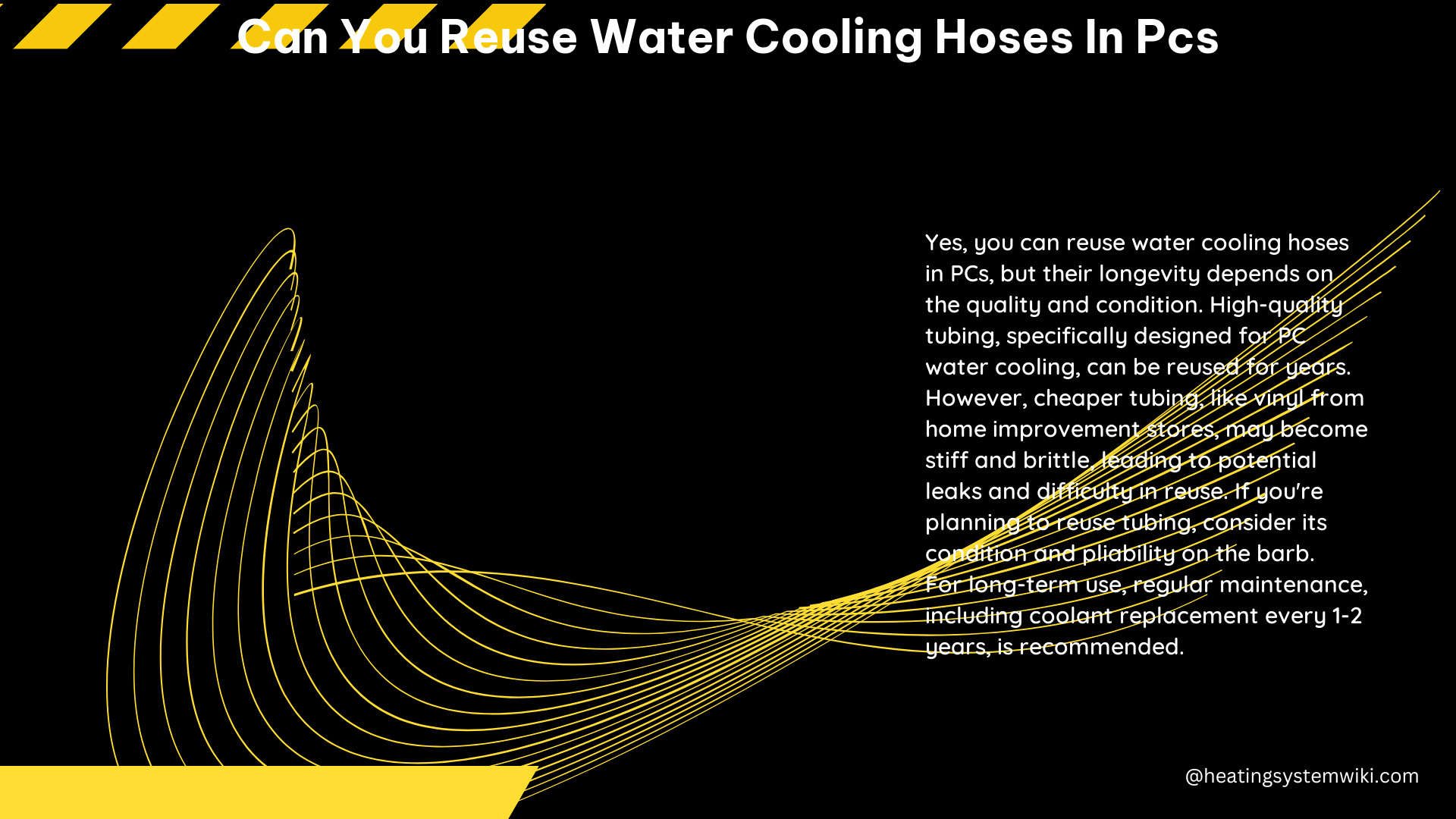When it comes to water-cooled PCs, the question of whether you can reuse the cooling hoses is a common one. The answer is yes, you can reuse water cooling hoses, but there are several important factors to consider before doing so. In this comprehensive guide, we’ll dive deep into the technical details and provide you with a step-by-step playbook to ensure a successful and safe reuse of your water cooling hoses.
Understanding Tubing Materials
The type of tubing material used in your water cooling system plays a crucial role in determining its reusability. Generally, there are two main types of water cooling tubing: soft tubing and hard tubing.
Soft Tubing
Soft tubing, such as PVC or silicone, is more flexible and less prone to cracking compared to hard tubing. This makes soft tubing a better candidate for reuse, as it can withstand the stress of being removed and reinstalled more easily. However, even soft tubing can become brittle or damaged over time, leading to potential leaks or poor seals.
Hard Tubing
Hard tubing, typically made of acrylic or PETG, is more rigid and less forgiving than soft tubing. While hard tubing can provide a sleeker, more professional look, it is more susceptible to cracking and breaking during the removal and reinstallation process. Reusing hard tubing requires extra caution and may not be recommended in many cases.
Evaluating Tubing Condition

The age and usage history of the water cooling hoses are essential factors to consider when deciding whether to reuse them. If the tubing has been in use for an extended period, it may have degraded, leading to a higher risk of leaks or reduced performance.
Inspection
Before reusing water cooling hoses, it’s crucial to inspect them carefully for signs of wear, damage, or leaks. Look for cracks, brittleness, discoloration, or any other visible signs of deterioration. If the tubing appears compromised in any way, it’s best to replace it to avoid potential issues.
Pressure Testing
In addition to a visual inspection, it’s recommended to perform a pressure test on the water cooling hoses before reusing them. This can be done by connecting the hoses to a water source and applying a moderate amount of pressure (around 5-10 PSI) to check for any leaks or weak points in the tubing.
Ensuring Compatibility
When reusing water cooling hoses, it’s essential to ensure that they fit properly in the new system. This may require measuring the tube lengths and diameters to ensure compatibility with the new case and cooling components.
Measurements
Carefully measure the length and diameter of the existing water cooling hoses. Compare these measurements to the requirements of your new system to ensure a proper fit. If the hoses are too long or too short, you may need to cut and reattach the tubing, which can introduce additional risks if the tubing is brittle or damaged.
Fittings and Connections
In addition to the tubing dimensions, you’ll also need to ensure that the fittings and connections on the new system are compatible with the existing hoses. Check the thread size, diameter, and any other relevant specifications to avoid any compatibility issues.
Preparing for Reuse
Before reinstalling the water cooling hoses, it’s crucial to thoroughly clean and prepare them for the new system.
Flushing and Cleaning
Flush the water cooling hoses with a suitable cleaning solution to remove any accumulated debris, mineral deposits, or contaminants that may have built up over time. This will help ensure the hoses are in optimal condition for reuse.
Replacing Seals and Gaskets
Inspect all the seals and gaskets associated with the water cooling hoses, and replace any that appear worn or damaged. This will help prevent leaks and ensure a secure connection in the new system.
Reinstallation and Testing
Once you’ve prepared the water cooling hoses for reuse, it’s time to reinstall them in the new system. Follow these steps carefully to ensure a successful and safe installation.
Reinstallation
Carefully route the water cooling hoses through the new case, ensuring they are not kinked or twisted. Secure the hoses in place using the appropriate clamps or fittings, and double-check all connections for a tight fit.
Leak Testing
After the hoses are installed, perform a thorough leak test by filling the system with water and closely monitoring it for any signs of leaks. Let the system run for at least 24 hours to ensure there are no issues.
Performance Monitoring
Once the system is up and running, closely monitor the water cooling performance to ensure it is operating as expected. Keep an eye on temperatures, flow rates, and any other relevant metrics to identify any potential issues.
Conclusion
Reusing water cooling hoses in PCs can be a cost-effective and environmentally-friendly option, but it requires careful consideration and attention to detail. By understanding the technical specifications, evaluating the tubing condition, ensuring compatibility, and following proper installation and testing procedures, you can successfully reuse your water cooling hoses and maintain optimal performance in your system.
Remember, safety should always be the top priority when working with water-cooled PCs. If you have any doubts or concerns about the reusability of your water cooling hoses, it’s best to err on the side of caution and replace them with new components.
References:
- [SOLVED] – Do I need to renew water cooling? https://forums.tomshardware.com/threads/do-i-need-to-renew-water-cooling.3530564/
- Is watercooling reusable? – EVGA Forums https://forums.evga.com/Is-watercooling-reusable-m873244.aspx
- Reuse soft tubes | Overclock.net https://www.overclock.net/threads/reuse-soft-tubes.1639222/
- Reusing soft tubing : r/watercooling – Reddit https://www.reddit.com/r/watercooling/comments/6vrqv0/reusing_soft_tubing/
